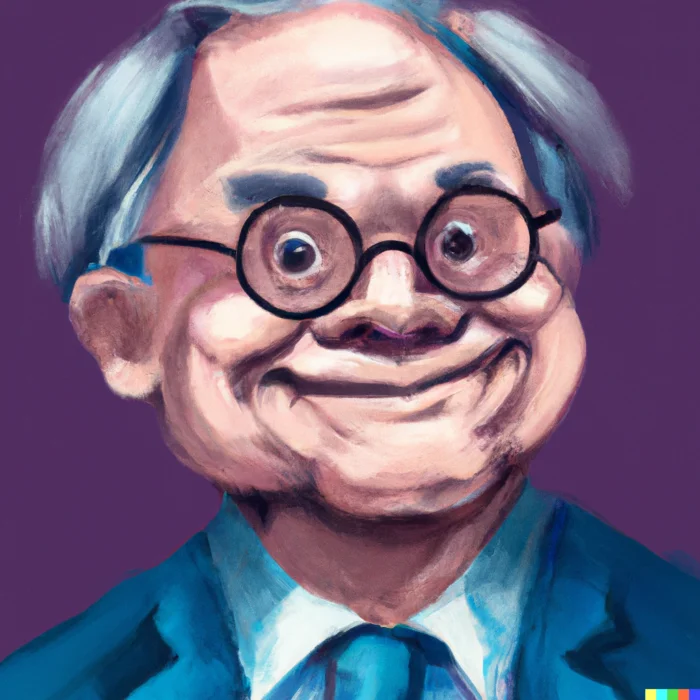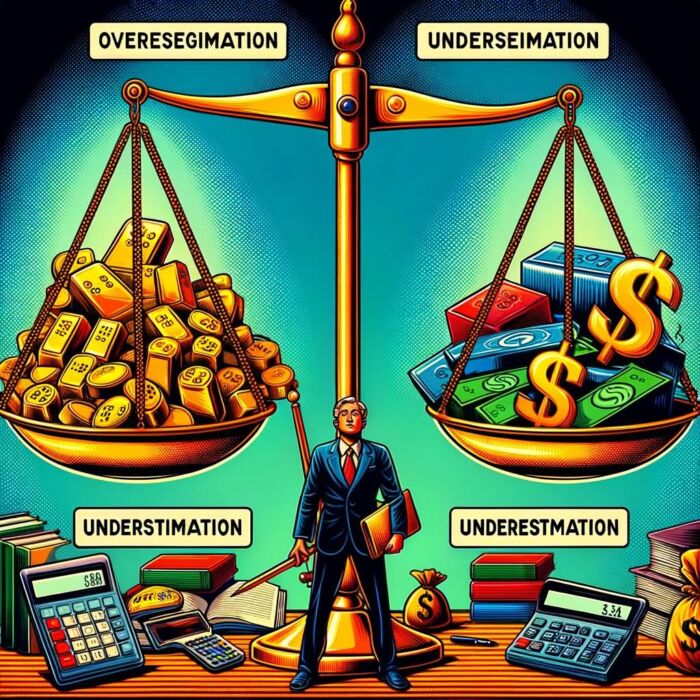Warren Buffett, affectionately known as the “Oracle of Omaha,” is one of the most successful investors in history. His approach to investing is akin to a meticulous craftsman who, rather than seeking quick profits, looks for long-term value. He is a proponent of value investing, a method first introduced by his mentors Benjamin Graham and David Dodd, which involves buying stocks at a price less than their fundamental worth.

Definition of Intrinsic Value
Intrinsic value is a cornerstone of Buffett’s investment philosophy. In its simplest form, intrinsic value is the actual worth of a company, independent of its current stock price. It reflects the perceived value of a company’s future earnings, assets, cash flow, and overall potential. Importantly, intrinsic value is not a static figure but can change with business prospects and economic conditions.

Importance of Intrinsic Value in Buffett’s Stock Selection Process
Buffett’s genius, in part, comes from his ability to calculate and appreciate intrinsic value. Rather than focusing on short-term market trends or momentary stock prices, he uses intrinsic value as a compass guiding him towards undervalued companies with promising prospects. His ability to buy these ‘diamonds in the rough’ and patiently hold onto them has allowed his portfolio and Berkshire Hathaway’s value to skyrocket over time.

In essence, understanding Buffett’s relationship with intrinsic value is like peeking into the mastermind’s laboratory, offering invaluable insights into his investment strategy. As we dive deeper into this concept, we’ll uncover the Oracle’s secrets and learn how they can inform our own investment decisions. After all, as the saying goes, when the master points at the moon, the wise student looks not at the finger, but at the moon.

Warren Buffett’s Understanding of Intrinsic Value
To Buffett, intrinsic value is the estimation of a company’s future cash flow, discounted back to the present. He envisions it as the total cash that can be taken out of a business during its remaining life, brought to present value. It’s like peering into a crystal ball to forecast a company’s financial future. This calculation, while seemingly straightforward, requires astute business judgement and an understanding of market dynamics.

Connection of Intrinsic Value to Buffett’s Value Investing Approach
Buffett’s approach to value investing is intrinsically linked with the concept of intrinsic value. Imagine a flea market where most sellers and buyers determine the worth of goods based on what others are bidding or asking. But in the midst of the chaos, there’s Buffett, armed with his intrinsic value compass, assessing items based on their actual worth and patiently waiting for a deal. This scenario sums up Buffett’s investing approach: he seeks out quality businesses trading at prices below their intrinsic value, purchases them, and then patiently waits for the market to realize their true worth.
How Intrinsic Value Differs from Market Price
Market price, the price at which a stock is currently trading, often oscillates around the intrinsic value like a moth around a flame. At times, due to short-term factors or market sentiment, the price might significantly deviate from the intrinsic value. In Buffett’s words, “Price is what you pay; value is what you get.”
For instance, during a market panic, the prices of fundamentally strong companies may fall drastically, creating a gap between the intrinsic value and the market price. Buffett, like a seasoned fisherman, waits for these moments to cast his line, buying quality businesses at a discount. He understands that over time, market price tends to gravitate back towards intrinsic value, leading to substantial returns. As we venture further into Buffett’s world, we’ll see this principle in action, showing us the wisdom in his timeless advice, “Be fearful when others are greedy, and be greedy when others are fearful.”
source: New Money on YouTube
Calculating Intrinsic Value: The Buffett Way
Key Factors Considered by Buffett
When determining the intrinsic value of a company, Buffett takes various factors into account. He evaluates the company’s financial statements, including its revenue, earnings, and cash flow. He looks for consistent and predictable growth in these areas, indicating a stable and profitable business. Buffett also considers the company’s management team, its industry position, and its competitive advantages. These factors help him gauge the company’s potential for long-term success and sustainable profitability.

Warren Buffett’s Discounted Cash Flow (DCF) Analysis
One of the primary tools Buffett employs to calculate intrinsic value is the Discounted Cash Flow (DCF) analysis. This approach estimates the present value of a company’s future cash flows by discounting them back to the present at an appropriate rate. By assessing the cash the business is expected to generate over its lifespan, Buffett determines its intrinsic value.
This method requires making assumptions about future cash flow growth rates and the appropriate discount rate, which accounts for the time value of money and the company’s risk. While it may seem complex, DCF analysis enables Buffett to assess the long-term earning potential of a business, providing a solid foundation for his investment decisions.
Significance of Competitive Advantage or ‘Moat’ in Intrinsic Value Calculation
For Buffett, a crucial aspect of assessing intrinsic value is evaluating a company’s competitive advantage, often referred to as its ‘moat.’ A moat represents a sustainable competitive advantage that sets a company apart from its competitors and protects its long-term profitability.
Buffett looks for businesses with wide and enduring moats, such as strong brands, high entry barriers, cost advantages, or intellectual property rights. These moats provide a level of protection, allowing the company to maintain market share, generate consistent cash flows, and sustain competitive advantages over time. The presence of a durable moat enhances the confidence in the accuracy of the intrinsic value calculation, as it supports the company’s ability to maintain profitability and fend off competitors.
By considering these key factors and employing the DCF analysis with a keen eye on a company’s competitive advantage, Buffett gains insights into a company’s intrinsic value. This meticulous approach sets him apart as an astute investor and serves as a valuable lesson for those seeking to navigate the intricate world of stock investing.
source: The Long-Term Investor on YouTube

Buffett’s Use of Intrinsic Value in Stock Selection
Illustration of Buffett’s Stock Selection Using Intrinsic Value
Buffett’s use of intrinsic value in stock selection is akin to a skilled art curator handpicking masterpieces for a prestigious gallery. He searches for undervalued companies with strong competitive advantages and robust long-term prospects. When the market price of such companies falls below their estimated intrinsic value, Buffett sees an opportunity to invest.
By assessing the company’s intrinsic value, he determines whether the margin of safety – the difference between the intrinsic value and the market price – is wide enough to provide a cushion against potential downside risks. This disciplined approach allows Buffett to acquire shares at attractive prices, which can lead to substantial gains when the market eventually recognizes the company’s true worth.
Case Studies of Buffett’s Investments
Buffett’s investment history is rich with successful applications of his intrinsic value approach. For example, his investment in Coca-Cola showcases his belief in the enduring power of a strong brand and a wide moat. He recognized the company’s ability to generate consistent cash flows from its global presence and loyal customer base, leading him to invest heavily in the company.
Another notable investment is American Express. Buffett saw the potential for long-term growth in the credit card industry and believed in American Express’ competitive advantages. He understood the company’s ability to generate significant earnings and consistently increase its intrinsic value over time.
These case studies highlight how Buffett’s focus on intrinsic value and competitive advantage has driven his investment decisions, enabling him to build a remarkable track record of wealth creation.

Lessons for Individual Investors
Buffett’s investment approach provides valuable lessons for individual investors:
- Think long-term: Buffett’s success stems from his ability to patiently hold investments for the long haul. Avoid getting caught up in short-term market fluctuations and focus on the intrinsic value of a company.
- Seek competitive advantages: Look for companies with durable competitive advantages or moats. These advantages can help protect a company’s profitability and make it a solid long-term investment.
- Conduct thorough research: Analyze a company’s financials, industry dynamics, and competitive position. Understand the factors that contribute to its intrinsic value.
- Maintain a margin of safety: Seek opportunities where the market price is significantly lower than the estimated intrinsic value. This provides a buffer against unforeseen risks.
- Be disciplined: Stick to your investment strategy and avoid being swayed by short-term market sentiment or noise. Stay true to your intrinsic value assessment and invest with conviction.
By incorporating these lessons into their investment approach, individual investors can align themselves with Buffett’s philosophy and increase their chances of achieving long-term investment success.
source: Lucky Investment Wisdom on YouTube
The Role of Patience and Discipline in Buffett’s Approach
Buying Stocks at a Discount to Intrinsic Value
Warren Buffett’s investment strategy is rooted in the principle of buying stocks at a discount to their intrinsic value. Like a savvy shopper at a clearance sale, Buffett patiently waits for the right opportunity to acquire shares of high-quality companies when their market prices fall below their estimated intrinsic value.
By purchasing stocks at a discount, Buffett creates a margin of safety that protects against potential losses and increases the potential for long-term gains. This disciplined approach allows him to capitalize on market mispricing and provides a buffer against unforeseen risks.
Holding Stocks for the Long-term
Buffett’s approach to investing can be likened to tending a fruitful orchard. Once he identifies a company with strong fundamentals and a wide moat, he exhibits unwavering patience and holds onto the stock for the long haul. He believes in the power of compounding over time, allowing his investments to grow and deliver substantial returns.
Buffett’s long-term perspective counters the prevailing short-term mindset prevalent in the investment world. He emphasizes the importance of focusing on the underlying value of a company and its ability to generate sustainable profits over many years, rather than getting caught up in market fluctuations.

Sticking to the Circle of Competence
Buffett advocates for staying within one’s circle of competence, which he defines as investing in businesses that can be easily understood and analyzed. He famously quipped, “Risk comes from not knowing what you’re doing.” By staying within his realm of expertise, Buffett minimizes the risk of making uninformed investment decisions.
This disciplined approach requires acknowledging one’s limitations and avoiding investments in areas beyond one’s comprehension. Buffett narrows his focus to industries and companies he understands well, enabling him to make informed judgments about a company’s intrinsic value and competitive advantage.
By combining patience, discipline, and a focus on one’s circle of competence, Buffett has been able to build his wealth and achieve remarkable investment success over the decades. These principles offer valuable guidance for individual investors who aspire to adopt a long-term, disciplined approach to wealth creation. Emulating Buffett’s patience in buying at a discount, his commitment to long-term holding, and his adherence to a circle of competence can provide a solid foundation for achieving investment success.
source: The Financial Review on YouTube
Limitations and Risks of Using Intrinsic Value
Subjectivity in Intrinsic Value Calculation
While intrinsic value serves as a guiding principle for Warren Buffett, it is important to acknowledge that calculating intrinsic value involves a degree of subjectivity. Estimating future cash flows, growth rates, and discount rates requires making assumptions that may vary among investors. Different analysts may arrive at different intrinsic value estimates for the same company based on their individual judgments and methodologies. It is crucial to recognize that intrinsic value calculations are not an exact science but rather an informed estimation.

Risk of Overestimation and Underestimation
Another inherent risk in using intrinsic value is the potential for overestimation or underestimation. The accuracy of intrinsic value calculations heavily relies on the accuracy of the assumptions made. If future cash flows or growth rates are overestimated, the calculated intrinsic value may be inflated, leading to an overvaluation of the stock. Conversely, underestimating future prospects may result in undervaluing a stock and missing out on potential opportunities. The risk of misjudging intrinsic value highlights the importance of conducting thorough research and maintaining a margin of safety when making investment decisions.
Importance of Regular Review and Adjustment
Recognizing the limitations and risks of intrinsic value calculations, it is crucial for investors to regularly review and adjust their assessments. Business dynamics, competitive landscapes, and economic conditions change over time, impacting a company’s intrinsic value. It is essential to stay informed about relevant market developments and adjust intrinsic value estimates accordingly. Regular review helps investors avoid complacency and ensures that their investment decisions remain aligned with the evolving fundamentals of the companies they hold.
Moreover, adjustments should not only be made to intrinsic value estimates but also to the margin of safety. As market conditions fluctuate, the gap between intrinsic value and market price can narrow or widen. Investors should reevaluate their margin of safety to ensure it remains appropriate given the prevailing market environment.
By acknowledging the subjectivity of intrinsic value calculations, being aware of the risks of overestimation and underestimation, and regularly reviewing and adjusting intrinsic value estimates, investors can navigate the potential pitfalls associated with intrinsic value analysis. It is through a balanced and informed approach that investors can enhance their ability to make sound investment decisions based on intrinsic value while managing the inherent uncertainties of the financial markets.
source: Investor Talk on YouTube
12-Question FAQ: How Warren Buffett Uses Intrinsic Value to Buy Stocks
1) What does Warren Buffett mean by “intrinsic value”?
Intrinsic value is Buffett’s estimate of the present value of all the cash a business can generate over its remaining life. It’s an owner’s perspective: what the whole company is worth today based on the cash it will produce tomorrow.
2) How is intrinsic value different from market price?
Market price is what the stock trades for at this moment; intrinsic value is what the business is actually worth based on fundamentals. Price can swing with sentiment; value changes mainly when business prospects change. Buffett buys when the gap (discount) is wide.
3) How does Buffett roughly calculate intrinsic value?
He focuses on owner earnings (free cash flow available to shareholders) and discounts those future streams back to the present using a rate that reflects opportunity cost and risk. This is a practical version of discounted cash flow (DCF), informed by judgment rather than a hyper-precise model.
4) What discount rate would Buffett use?
He’s historically anchored on a conservative baseline (e.g., long-term U.S. rates) plus a healthy safety buffer. The point isn’t a perfect number; it’s to avoid rosy assumptions and ensure the investment still works under sober rates.
5) Why is a “margin of safety” essential?
Even careful intrinsic value estimates are imprecise. Buying at a meaningful discount to intrinsic value creates a cushion against errors in forecasting, adverse cycles, and unforeseen events—reducing downside while preserving upside.
6) How do economic moats factor into intrinsic value?
Wide, durable moats (brand, cost advantage, network effects, switching costs, regulation/IP) make future cash flows more predictable. Higher predictability raises confidence in the estimate and supports paying a fair price for quality.
7) What business qualities does Buffett prefer before running numbers?
Simple, understandable models; consistent profitability; strong returns on invested capital; prudent leverage; candid, capable managers; and reinvestment opportunities at high incremental returns. He’d rather value a wonderful business than a merely cheap one.
8) How does Buffett handle growth in the valuation?
He seeks sustainable growth backed by economics (not just sales lines going up). Growth only adds value if it comes with attractive returns on capital and doesn’t require excessive debt or dilution to finance it.
9) How often should intrinsic value be updated?
When facts change: new capital allocation decisions, a moat strengthens/weakens, industry structure shifts, cost of capital moves, or a cycle materially alters demand/pricing. Intrinsic value is a living estimate, not a once-and-done figure.
10) What’s the role of patience and temperament in Buffett’s process?
Patience creates selectivity on entry and commitment after purchase. Buffett waits for fat pitches (clear discounts to value) and then holds through noise so compounding can work. Temperament turns a sound estimate into a successful outcome.
11) Can individuals apply Buffett’s method without complex models?
Yes. Keep it simple: estimate owner earnings, apply conservative growth, use a sober discount rate, demand a margin of safety, and favor understandable, moat-protected businesses. Avoid precision theater—aim for approximately right over precisely wrong.
12) What are common pitfalls to avoid when using intrinsic value?
Over-optimistic growth/terminal values, ignoring cyclicality, underestimating capital intensity, using leverage to “manufacture” returns, and stretching beyond your circle of competence. If you can’t value it simply, pass.
Conclusion: Warren Buffett’s Use of Intrinsic Value in Stock Selection
Warren Buffett’s utilization of intrinsic value in his stock selection process is the bedrock of his investment philosophy. By calculating the intrinsic value of a company and buying stocks at a discount to that value, Buffett aims to achieve long-term growth and wealth accumulation. His disciplined approach, centered around identifying businesses with competitive advantages and holding them for the long haul, has been instrumental in his remarkable investment success.

The Lasting Influence of Buffett’s Investment Philosophy
Warren Buffett’s investment philosophy has left an indelible mark on the world of finance. His steadfast commitment to intrinsic value, patience, and long-term thinking has inspired countless investors and fund managers. Buffett’s success is a testament to the enduring principles of value investing and the importance of a rational and disciplined approach to stock selection. His influence extends beyond his own portfolio, shaping the investment strategies and mindsets of investors around the globe.
Final Thoughts for Individual Investors
As individual investors, we can draw valuable insights from Warren Buffett’s use of intrinsic value. Firstly, it is essential to prioritize a company’s intrinsic value over short-term market fluctuations. By focusing on the long-term prospects of a business, we can resist the temptations of speculative trading and make informed investment decisions.
Secondly, cultivating patience and discipline is crucial. Buffett’s ability to hold onto quality investments for extended periods has contributed significantly to his success. By avoiding knee-jerk reactions to market volatility and staying focused on the underlying value of a company, we can create opportunities for long-term wealth accumulation.
Lastly, continuous learning and critical thinking are vital. Buffett’s success is built on a foundation of extensive research and a deep understanding of the businesses he invests in. As individual investors, we should strive to expand our knowledge, develop a circle of competence, and make informed judgments about the intrinsic value of the companies we consider for investment.
In conclusion, Warren Buffett’s emphasis on intrinsic value has revolutionized the field of investing. His unwavering commitment to long-term value creation, coupled with his disciplined approach, serves as a beacon for individual investors seeking to navigate the complex world of stocks. By incorporating Buffett’s principles into our investment strategies, we can cultivate a mindset that focuses on intrinsic value, embraces patience, and ultimately increases our chances of achieving sustainable investment success.
Important Information
Comprehensive Investment Disclaimer:
All content provided on this website (including but not limited to portfolio ideas, fund analyses, investment strategies, commentary on market conditions, and discussions regarding leverage) is strictly for educational, informational, and illustrative purposes only. The information does not constitute financial, investment, tax, accounting, or legal advice. Opinions, strategies, and ideas presented herein represent personal perspectives, are based on independent research and publicly available information, and do not necessarily reflect the views or official positions of any third-party organizations, institutions, or affiliates.
Investing in financial markets inherently carries substantial risks, including but not limited to market volatility, economic uncertainties, geopolitical developments, and liquidity risks. You must be fully aware that there is always the potential for partial or total loss of your principal investment. Additionally, the use of leverage or leveraged financial products significantly increases risk exposure by amplifying both potential gains and potential losses, and thus is not appropriate or advisable for all investors. Using leverage may result in losing more than your initial invested capital, incurring margin calls, experiencing substantial interest costs, or suffering severe financial distress.
Past performance indicators, including historical data, backtesting results, and hypothetical scenarios, should never be viewed as guarantees or reliable predictions of future performance. Any examples provided are purely hypothetical and intended only for illustration purposes. Performance benchmarks, such as market indexes mentioned on this site, are theoretical and are not directly investable. While diligent efforts are made to provide accurate and current information, “Picture Perfect Portfolios” does not warrant, represent, or guarantee the accuracy, completeness, or timeliness of any information provided. Errors, inaccuracies, or outdated information may exist.
Users of this website are strongly encouraged to independently verify all information, conduct comprehensive research and due diligence, and engage with qualified financial, investment, tax, or legal professionals before making any investment or financial decisions. The responsibility for making informed investment decisions rests entirely with the individual. “Picture Perfect Portfolios” explicitly disclaims all liability for any direct, indirect, incidental, special, consequential, or other losses or damages incurred, financial or otherwise, arising out of reliance upon, or use of, any content or information presented on this website.
By accessing, reading, and utilizing the content on this website, you expressly acknowledge, understand, accept, and agree to abide by these terms and conditions. Please consult the full and detailed disclaimer available elsewhere on this website for further clarification and additional important disclosures. Read the complete disclaimer here.





